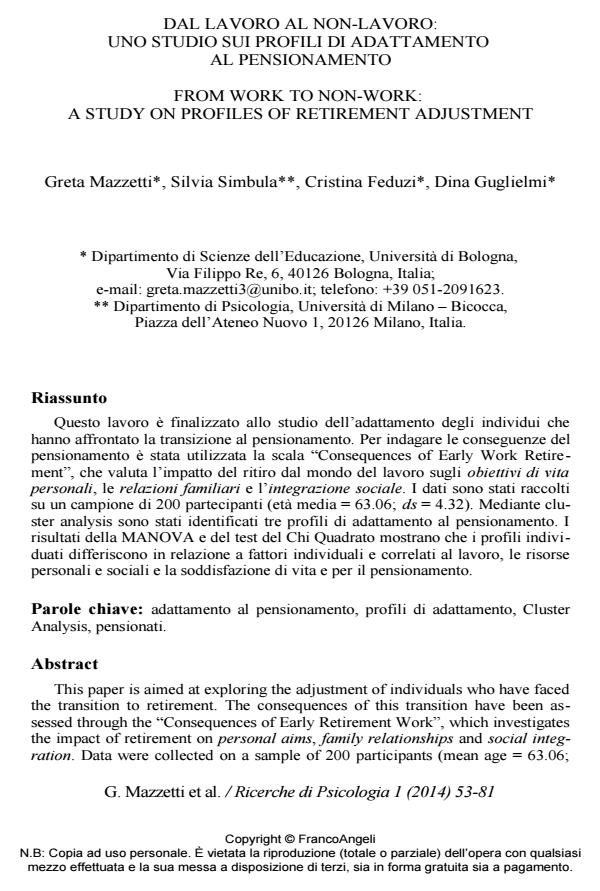Dal lavoro al non-lavoro: uno studio sui profili di adattamento al pensionamento
Titolo Rivista RICERCHE DI PSICOLOGIA
Autori/Curatori Greta Mazzetti, Silvia Simbula, Cristina Feduzi, Dina Guglielmi
Anno di pubblicazione 2014 Fascicolo 2014/1
Lingua Italiano Numero pagine 29 P. 53-81 Dimensione file 309 KB
DOI 10.3280/RIP2014-001003
Il DOI è il codice a barre della proprietà intellettuale: per saperne di più
clicca qui
Qui sotto puoi vedere in anteprima la prima pagina di questo articolo.
Se questo articolo ti interessa, lo puoi acquistare (e scaricare in formato pdf) seguendo le facili indicazioni per acquistare il download credit. Acquista Download Credits per scaricare questo Articolo in formato PDF

FrancoAngeli è membro della Publishers International Linking Association, Inc (PILA)associazione indipendente e non profit per facilitare (attraverso i servizi tecnologici implementati da CrossRef.org) l’accesso degli studiosi ai contenuti digitali nelle pubblicazioni professionali e scientifiche
Questo lavoro e finalizzato allo studio dell’adattamento degli individui che hanno affrontato la transizione al pensionamento. Per indagare le conseguenze del pensionamento e stata utilizzata la scala "Consequences of Early Work Retirement", che valuta l’impatto del ritiro dal mondo del lavoro sugli obiettivi di vita personali, le relazioni familiari e l’integrazione sociale. I dati sono stati raccolti su un campione di 200 partecipanti (eta media = 63.06; ds = 4.32). Mediante cluster analysis sono stati identificati tre profili di adattamento al pensionamento. I risultati della MANOVA e del test del Chi Quadrato mostrano che i profili individuati differiscono in relazione a fattori individuali e correlati al lavoro, le risorse personali e sociali e la soddisfazione di vita e per il pensionamento.
Parole chiave:Adattamento al pensionamento, profili di adattamento, Cluster Analysis, pensionati.
Greta Mazzetti, Silvia Simbula, Cristina Feduzi, Dina Guglielmi, Dal lavoro al non-lavoro: uno studio sui profili di adattamento al pensionamento in "RICERCHE DI PSICOLOGIA " 1/2014, pp 53-81, DOI: 10.3280/RIP2014-001003